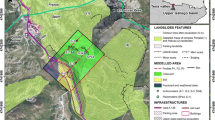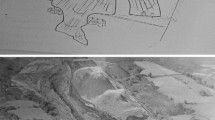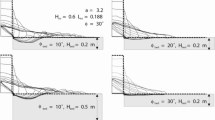Abstract
This paper deals with modelling of landslide propagation. Its purpose is to present a methodology of analysis based on mathematical, constitutive and numerical modelling, which includes both well-established theories together with some improvements which are proposed herein. Concerning the mathematical model, it is based on Biot–Zienkiewicz equations, from where a depth-integrated model is developed. The main contribution here is to combine a depth-integrated description of the soil–pore fluid mixture together with a set of 1D models dealing with pore pressure evolution within the soil mass. In this way, pore pressure changes caused by vertical consolidation, changes of total stresses resulting from height variations and changes of basal surface permeability can be taken into account with more precision. Most of rheological models used in depth-integrated models are derived either heuristically (the case of Voellmy model, for instance), or from general 3D rheological models. Here, we will propose an alternative way, based on Perzyna’s viscoplasticity. The approach followed for numerical modelling is the SPH method, which we have enriched adding a 1D finite difference grid to each SPH node, in order to improve the description of pore water profiles in the avalanching soil. This paper intends to be a homage to Professor Felix Darve, who has very much contributed to the field of modern geomechanics.
Similar content being viewed by others
References
Sulem J., Vardoulakis I.G.: Bifurcation Analysis in Geomechanics. Taylor & Francis, London (1995)
Laouafa F., Darve F.: Modelling of slope failure by a material instability mechanism. Comput. Geotech. 29, 301–325 (2002)
Saint-Venant A.: Theorie du mouvement non permanent des eaux, avec application aux crues des rivieres et a l’introduction de marees dans leurs lits. Comptes-Rendus l’Académie des Sci. 73, 147–273 (1871)
Savage S.B., Hutter K.: The motion of a finite mass of granular material down a rough incline. J. Fluid Mech. 199, 177 (2006)
Iverson R.M., Denlinger R.P.: Flow of variably fluidized granular masses across three-dimensional terrain: 1. Coulomb mixture theory. J. Geophys. Res. 106, 537 (2001)
Hutter K., Koch T.: Motion of a granular avalanche in an exponentially curved chute: experiments and theoretical predictions. Philos. Trans. R. Soc. A Math. Phys. Eng. Sci. 334, 93–138 (1991)
Naaim, M., Vial, S., Couture, R.: St Venant approach for rock avalanches modelling in multiple scale analyses and coupled physical systems (1997)
Laigle D., Coussot P.: Numerical modeling of mudflows. J. Hydraul. Eng. 123, 617–623 (1997)
Pitman E.B., Le L.: A two-fluid model for avalanche and debris flows. Philos. Trans. A. Math. Phys. Eng. Sci. 363, 1573–601 (2005)
McDougall S., Hungr O.: A model for the analysis of rapid landslide motion across three-dimensional terrain. Can. Geotech. J. 41, 1084–1097 (2004)
Rodriguez-Paz M., Bonet J.: A corrected smooth particle hydrodynamics formulation of the shallow–water equations. Comput. Struct. 83, 1396–1410 (2005)
Mangeney-Castelnau A.: Numerical modeling of avalanches based on Saint Venant equations using a kinetic scheme. J. Geophys. Res. 108, 2527 (2003)
Lajeunesse E., Mangeney-Castelnau A., Vilotte J.P.: Spreading of a granular mass on a horizontal plane. Phys. Fluids. 16, 2371 (2004)
Pastor M., Blanc T., Pastor M.J.: A depth-integrated viscoplastic model for dilatant saturated cohesive-frictional fluidized mixtures: Application to fast catastrophic landslides. J. Nonnewton. Fluid Mech. 158, 142–153 (2009)
Pastor M., Quecedo M., Fernández Merodo J.A., Herreros M.I., Gonzalez E., Mira P.: Modelling tailings dams and mine waste dumps failures. Géotechnique 52, 579–591 (2002)
Hutchinson J.N.: A sliding–consolidation model for flow slides. Can. Geotech. J. 23, 115–126 (1986)
Quecedo M., Pastor M., Herreros M.I., Fernández Merodo J.A.: Numerical modelling of the propagation of fast landslides using the finite element method. Int. J. Numer. Methods Eng. 59, 755–794 (2004)
Major J.J., Iverson R.M.: Debris-flow deposition: Effects of pore–fluid pressure and friction concentrated at flow margins. Geol. Soc. Am. Bull. 111, 1424–1434 (1999)
Iverson R.M.: Regulation of landslide motion by dilatancy and pore pressure feedback. J. Geophys. Res. 110, F02015 (2005)
Pudasaini S.P.: A general two-phase debris flow model. J. Geophys. Res. 117, F03010 (2012)
Okada Y., Sassa K., Fukuoka H.: Excess pore pressure and grain crushing of sands by means of undrained and naturally drained ring-shear tests. Eng. Geol. 75, 325–343 (2004)
Iverson R.I.: Landslide triggering by rain infiltration. Water Resour. Res. 36, 1897–1910 (2000)
Pailha M., Nicolas M., Pouliquen O.: Initiation of underwater granular avalanches: influence of the initial volume fraction. Phys. Fluids. 20, 111701 (2008)
Igwe, O., Sassa, K., Fukuoka, H.: Excess pore water pressure: a major factor for catastrophic landslides. In: The 10th IAEG International Congress. Nottingham, UK (2006)
Bowen, R.M.: Theory of mixtures, part I. In: Eringen, A.C. (ed.) Continuum Physics: mixtures and EM field theories, vol. III, pp. 2–122 (1976)
De Boer R.: Highlights in the historical development of the porous media theory: toward a consistent macroscopic theory. Appl. Mech. Rev. 49, 201 (1996)
Biot M.A.: General theory of three-dimensional consolidation. J. Appl. Phys. 12, 155 (1941)
Biot M.A.: Theory of elasticity and consolidation for a porous anisotropic solid. J. Appl. Phys. 26, 182 (1955)
Zienkiewicz O.C., Shiomi T.: Dynamic behaviour of saturated porous media; The generalized Biot formulation and its numerical solution. Int. J. Numer. Anal. Methods Geomech. 8, 71–96 (1984)
Zienkiewicz O.C., Chan A.H.C., Pastor M., Paul D.K., Shiomi T.: Static and dynamic behaviour of soils: a rational approach to quantitative solutions. I. Fully saturated problems. Proc. R. Soc. A Math. Phys. Eng. Sci. 429, 285–309 (1990)
Zienkiewicz O.C., Xie Y.M., Schrefler B.A., Ledesma A., Bicanic N.: Static and dynamic behaviour of soils: a rational approach to quantitative solutions. II. Semi-saturated problems. Proc. R. Soc. A Math. Phys. Eng. Sci. 429, 311–321 (1990)
Zienkiewicz O.C., Chan A.H.C., Pastor M., Schrefler B.A., Shiomi T.: Computational Geomechanics. Wiley, London (1999)
Lewis, R.W., Schrefler, B.A.: The finite element method in the static and dynamic deformation and consolidation of porous media (1998)
Coussy, O.: Mechanics of Porous Continua. Wiley, Chichester (1995)
De Boer R.: Trends in Continuum Mechanics of Porous Media. Springer, Berlin (2005)
Pastor M., Haddad B., Sorbino G., Cuomo S., Drempetic V.: A depth-integrated, coupled SPH model for flow-like landslides and related phenomena. Int. J. Numer. Anal. Methods Geomech. 33, 143–172 (2009)
Gray J.M.N.T., Thornton A.R.: A theory for particle size segregation in shallow granular free-surface flows. Proc. R. Soc. A Math. Phys. Eng. Sci. 461, 1447–1473 (2005)
Gray J.M.N.T., Ancey C.: Multi-component particle-size segregation in shallow granular avalanches. J. Fluid Mech. 678, 535–588 (2011)
Fernández-Merodo, J.A., García-Davalillo, J.C., Herrera, G., Mira, P., Pastor, M.: 2D viscoplastic finite element modelling of slow landslides: the Portalet case study (Spain). Landslides (2012)
Crosta G.B., Imposimato S., Roddeman D.: Numerical modelling of entrainment/deposition in rock and debris-avalanches. Eng. Geol. 109, 135–145 (2009)
Alonso E.E., Zabala F.: Progressive failure of Aznalcóllar dam using the material point method. Géotechnique 61, 795–808 (2011)
Blanc T., Pastor M.: A stabilized fractional step, Runge–Kutta Taylor SPH algorithm for coupled problems in geomechanics. Comput. Methods Appl. Mech. Eng. 221(222), 41–53 (2012)
Blanc T., Pastor M.: A stabilized Runge–Kutta, Taylor smoothed particle hydrodynamics algorithm for large deformation problems in dynamics. Int. J. Numer. Methods Eng. 91, 1427–1458 (2012)
Bui H.H., Sako K., Fukagawa R.: Numerical simulation of soil–water interaction using smoothed particle hydrodynamics (SPH) method. J. Terramechanics 44, 339–346 (2007)
Bui H.H., Fukagawa R., Sako K., Ohno S.: Lagrangian meshfree particles method (SPH) for large deformation and failure flows of geomaterial using elastic–plastic soil constitutive model. Int. J. Numer. Anal. Methods Geomech. 32, 1537–1570 (2008)
Jassim I., Stolle D., Vermeer P.: Two-phase dynamic analysis by material point method. Int. J. Numer. Anal. Methods Geomech. 37, 2502–2522 (2013)
Moresi L., Dufour F., Mühlhaus H.-B.: A Lagrangian integration point finite element method for large deformation modeling of viscoelastic geomaterials. J. Comput. Phys. 184, 476–497 (2003)
Savage S.B., Hutter K.: The dynamics of avalanches of granular materials from initiation to runout. Part I Anal. Acta Mech. 86, 201–223 (1991)
Hutter K., Siegel M., Savage S.B., Nohguchi Y.: Two-dimensional spreading of a granular avalanche down an inclined plane Part I. Theory. Acta Mech. 100, 37–68 (1993)
Gray J.M.N.T., Wieland M., Hutter K.: Gravity-driven free surface flow of granular avalanches over complex basal topography. Proc. R. Soc. A Math. Phys. Eng. Sci. 455, 1841–1874 (1999)
Pudasaini, S.P., Hutter, K.: Avalanche Dynamics: Dynamics of Rapid Flows of Dense Granular Avalanches (2007)
Iverson R.I.: The physics of debris flows. Rev. Geophys. 35, 245–296 (1997)
Wang Y., Hutter K.: A constitutive theory of fluid-saturated granular materials and its application in gravitational flows. Rheol. Acta. 38, 214–223 (1999)
Bingham E.C.: Fluidity and Plasticity. McGraw-Hill, New York (1922)
Hohenemser K., Prager W.: Über die Ansätze der Mechanik isotroper Kontinua. ZAMM—Zeitschrift für Angew. Math. und Mech. 12, 216–226 (1932)
Oldroyd J.G., Wilson A.H.: A rational formulation of the equations of plastic flow for a Bingham solid. Math. Proc. Camb. Philos. Soc. 43, 100 (2008)
Malvern L.E.: Introduction to the Mechanics of a Continuous Medium. Prentice Hall, Englewood Cliffs (1969)
Coussot P.: Steady, laminar, flow of concentrated mud suspensions in open channel. J. Hydraul. Res. 32, 535–559 (1994)
Coussot P.: Mudflow Rheology and Dynamics. Balkema, Amsterdam (1997)
Coussot P.: Rheometry of Pastes, Suspensions and Granular Matter. Wiley, London (2005)
Dent, J.D., Lang, T.E.: A biviscous modified bingham model of snow avalanche in motion. Ann. Glaciol. 4, 42–46 (1983)
Locat, J.: Normalized rheological behaviour of fine muds and their flow properties in a pseudoplastic regime. In: International Conference on Debris-Flow Hazard Mitigation: Prediction and Assessment. New York, pp. 260–269 (1997)
Chen J.K., Beraun J.E., Carney T.C.: A corrective smoothed particle method for boundary value problems in heat conduction. Int. J. Numer. Methods Eng. 46, 231–252 (1999)
Chen C., Ling C.-H.: Granular-flow rheology: role of shear-rate number in transition regime. J. Eng. Mech. 122, 469–480 (1996)
Forterre Y., Pouliquen O.: Flows of dense granular media. Annu. Rev. Fluid Mech. 40, 1–24 (2008)
Pailha M., Pouliquen O.: A two-phase flow description of the initiation of underwater granular avalanches. J. Fluid Mech. 633, 115 (2009)
Crosta G.B., Frattini P., Fusi N.: Fragmentation in the Val Pola rock avalanche, Italian Alps. J. Geophys. Res. 112, F01006 (2007)
Gray J.M.N.T., Ancey C.: Segregation, recirculation and deposition of coarse particles near two-dimensional avalanche fronts. J. Fluid Mech. 629, 387 (2009)
Johnson C.G., Kokelaar B.P., Iverson R.M., Logan M., LaHusen R.G., Gray J.M.N.T.: Grain-size segregation and levee formation in geophysical mass flows. J. Geophys. Res. 117, F01032 (2012)
Astarita G., Marucci G.: Principles of Non-newtonian Fluid Mechanics. McGraw-Hill, New York (1974)
Bagnold R.A.: Experiments on a gravity-free dispersion of large solid spheres in a newtonian fluid under shear. Proc. R. Soc. A Math. Phys. Eng. Sci. 225, 49–63 (1954)
Pouliquen O., Cassar C., Jop P., Forterre Y., Nicolas M.: Flow of dense granular material: towards simple constitutive laws. J. Stat. Mech. Theory Exp. 2006, P07020–P07020 (2006)
Jop P., Forterre Y., Pouliquen O.: A constitutive law for dense granular flows. Nature 441, 727–30 (2006)
George, D.L., Iverson, R.I.: A two phase debris flow model that includes coupled evolution of volume fractions, granular dilatancy and pore fluid pressure. In: 5th International Conference on Debris-Flow Hazards Mitigation: Mechanics, Prediction and Assessment, Roma, pp. 415–424 (2011)
Voellmy, A.: Über die Zerstörungskraft von Lawinen. (1955)
Parry R.H.G.: Triaxial compression and extension tests on remoulded saturated clay. Géotechnique 10, 166–180 (1960)
Hanes D.M., Inman D.L.: Observations of rapidly flowing granular-fluid materials. J. Fluid Mech. 150, 357 (2006)
MIDI G.R.: On dense granular flows. Eur. Phys. J. E. Soft Matter. 14, 341–65 (2004)
Roux, S., Radjai, F.: Texture-dependent rigid-plastic behavior. Phys. Dry Granul. Media 350, 229–236 (1998)
Perzyna P.: The constitutive equations for rate sensitive plastic materials. Q. Appl. Math. 20, 321–332 (1963)
Sluys, L.J., de Borst, R.: Wave propagation in strain softening plasticity. In: Modern Approaches to Plasticity, pp. 411–447 (1993)
Sluys, L.J.: Wave propagation, localization and dispersion in softening solids (1992)
Duvant, J., Lion, J.L.: Les inéquations en mécanique et en physique. Dunod (1972)
Winnicki A., Pearce C.J., Bićanić N.: Viscoplastic Hoffman consistency model for concrete. Comput. Struct. 79, 7–19 (2001)
Heeres O.M., Suiker A.S.J., de Borst R.: A comparison between the Perzyna viscoplastic model and the Consistency viscoplastic model. Eur. J. Mech. A/Solids. 21, 1–12 (2002)
Zienkiewicz O.C., Cormeau I.C.: Visco-plasticity–plasticity and creep in elastic solids—a unified numerical solution approach. Int. J. Numer. Methods Eng. 8, 821–845 (1974)
Adachi T., Oka F.: Constitutive equations for normally consolidated clays based on elasto viscoplasticity. Soils Found. 22, 57–70 (1982)
Desai C.S., Zhang D.: Viscoplastic model for geologic materials with generalized flow rule. Int. J. Numer. Anal. methods Geomech. 11, 603–620 (1987)
Vulliet L., Hutter K.: Continuum model for natural slopes in slow movement. Géotechnique 38, 199–217 (1988)
Ledesma, A., Olivella, S.: Creep of slopes controlled by rainfall: coupling viscoplasticity and unsaturated soil behaviour. In: Proceedings of the 1st Intenational Workshop on New Frontiers in Computational Geotechnics—IWS, pp. 91–98 (2002)
Perzyna P.: Fundamental problems in viscoplasticity. Adv. Appl. Mech. 9, 243–377 (1966)
Di Prisco C., Pisanò F.: An exercise on slope stability and perfect elastoplasticity. Géotechnique 61, 923–934 (2011)
Di Prisco C., Pastor M., Pisanò F.: Shear wave propagation along infinite slopes: a theoretically based numerical study. Int. J. Numer. Anal. Methods Geomech. 36, 619–642 (2012)
Pisanò F., Pastor M.: 1D wave propagation in saturated viscous geomaterials: Improvement and validation of a fractional step Taylor–Galerkin finite element algorithm. Comput. Methods Appl. Mech. Eng. 200, 3341–3357 (2011)
Herreros M.I., Mabssout M., Pastor M.: An eulerian mixed formulation for viscoplastic materials. Comput. Methods Appl. Mech. Eng. 196, 1924–1932 (2007)
Mabssout M., Pastor M.: A Taylor–Galerkin algorithm for shock wave propagation and strain localization failure of viscoplastic continua. Comput. Methods Appl. Mech. Eng. 192, 955–971 (2003)
Gingold, R.A., Monaghan, J.J.: Smoothed particle hydrodynamics—theory and application to non-spherical stars. Mon. Not. R. Astron. Soc. 181, 375–389 (1977)
Lucy L.B.: A numerical approach to the testing of the fission hypothesis. Astron. J. 82, 1013 (1977)
Liu, G.-R., Liu, M.B.: Smoothed Particle Hydrodynamics: A Meshfree Particle Method. Word Scientific, Singapore (2003)
Morris, J.P.: Analysis of Smoothed Particle Hydrodynamics with Applications. Monash University, Melbourne (1996)
Monaghan J.J., Kocharyan A.: SPH simulation of multi-phase flow. Comput. Phys. Commun. 87, 225–235 (1995)
Takeda H., Miyama S.M., Sekiya M.: Numerical simulation of viscous flow by smoothed particle hydrodynamics. Prog. Theor. Phys. 92, 939–960 (1994)
Monaghan J.J.: Simulating free surface flows with SPH. J. Comput. Phys. 110, 399–406 (1994)
Morris J.P., Fox P.J., Zhu Y.: Modeling low reynolds number incompressible flows using SPH. J. Comput. Phys. 136, 214–226 (1997)
Zhu Y., Fox P.J.: Smoothed particle hydrodynamics model for diffusion through porous media. Transp. Porous Media. 43, 441–471 (2001)
Bonet J., Kulasegaram S.: Correction and stabilization of smooth particle hydrodynamics methods with applications in metal forming simulations. Int. J. Numer. Methods Eng. 47, 1189–1214 (2000)
Randles P.W., Libersky L.D.: Normalized SPH with stress points. Int. J. Numer. Methods Eng. 48, 1445–1462 (2000)
Gray J.P., Monaghan J.J., Swift R.P.: SPH elastic dynamics. Comput. Methods Appl. Mech. Eng. 190, 6641–6662 (2004)
McDougall, S.: A new continuum dynamic model for the analysis of extremely rapid landslide motion across complex 3D terrain (2006)
Antoci C., Gallati M., Sibilla S.: Numerical simulation of fluid–structure interaction by SPH. Comput. Struct. 85, 879–890 (2007)
De Leffe, M., Le Touze, D., Alessandrini, B.: Coastal flow simulations using an SPH formulation modelling the non-linear shallow water equations. In: 3rd ERCOFTAC SPHERIC Workshop on SPH Applications. Lausanne, pp. 48–54 (2008)
Vacondio R., Rogers B.D., Stansby P.K., Mignosa P.: SPH modeling of shallow flow with open boundaries for practical flood simulation. J. Hydraul. Eng. 138, 530–541 (2012)
Dyka C.T., Randles P.W., Ingel R.P.: Stress points for tension instability in SPH. Int. J. Numer. Methods Eng. 40, 2325–2341 (1997)
Dyka C.T., Ingel R.P.: An approach for tension instability in smoothed particle hydrodynamics (SPH). Comput. Struct. 57, 573–580 (1995)
Swegle J.W., Hicks D.L., Attaway S.W.: Smoothed particle hydrodynamics stability analysis. J. Comput. Phys. 116, 123–134 (1995)
Blanc T., Pastor M.: A stabilized smoothed particle hydrodynamics, Taylor–Galerkin algorithm for soil dynamics problems. Int. J. Numer. Anal. Methods Geomech. 37, 1–30 (2013)
Cruden D.M., Hungr O.: The debris of the Frank Slide and theories of rockslide–avalanche mobility. Can. J. Earth Sci. 23, 425–432 (1986)
King, J.P.: The 2000 Tsing Shan Debris Flow. In: The Government of the Hong Kong Special Administrative Region (ed.) Tsing Shan debris flow and debris flood. Geo Report No. 281. Hong Kong, p. 265 (2001)
Jeyapalan J.K., Duncan J.M., Seed H.B.: Investigation of flow failures of tailings dams. J. Geotech. Eng. 109, 172–189 (1983)
Hutchinson, J.N.: Morphological and geotechnical parameters of landslides in relation to geology and hydrogeology. General report. In: 5th International Symposium on Landslides, Lausanne, pp. 3–35 (1988)
McConnell, R.G., Brock, R.W.: The great landslide at Frank, Alberta. Annual Report for the year 1902–1903, Part VIII (1904)
Author information
Authors and Affiliations
Corresponding author
Additional information
Communicated by Andreas Öchsner.
Rights and permissions
About this article
Cite this article
Pastor, M., Martin Stickle, M., Dutto, P. et al. A viscoplastic approach to the behaviour of fluidized geomaterials with application to fast landslides. Continuum Mech. Thermodyn. 27, 21–47 (2015). https://doi.org/10.1007/s00161-013-0326-5
Received:
Accepted:
Published:
Issue Date:
DOI: https://doi.org/10.1007/s00161-013-0326-5




